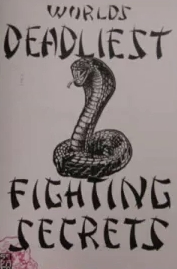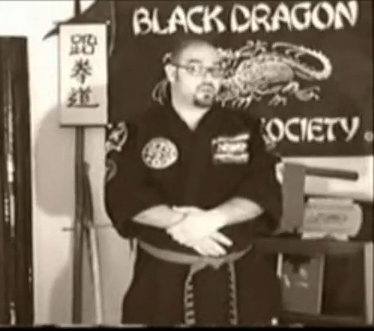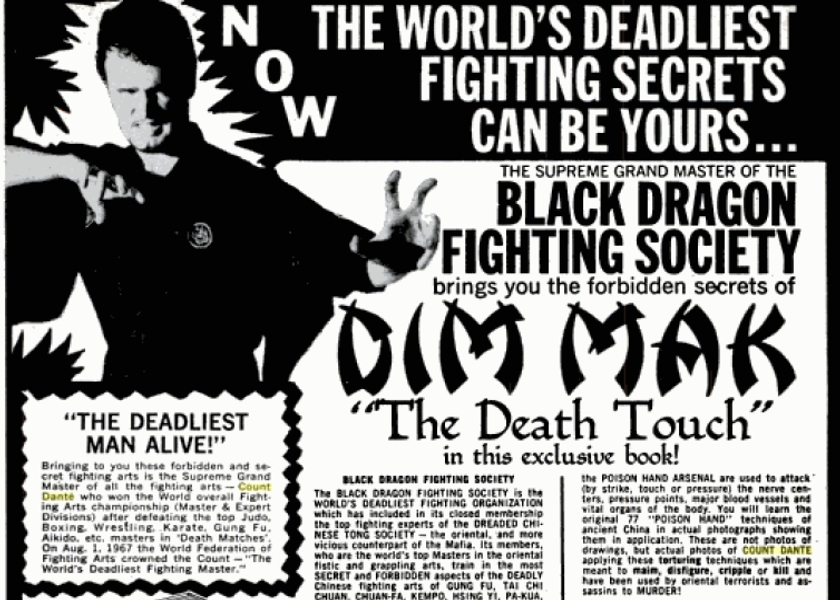Previously, in the martialmentary Who Was Count Dante, we examined the legacy of Count Dante, the man born John Keehan who, between 1964 and 1975, took the martial arts world by storm in crafting a provocative fictional persona. A curious mixture of showman and legitimately talented martial practitioner, Count Dante was reviled by the mainstream martial arts community as embodied by Black Belt magazine’s editorial positions. Focusing on full-contact, pragmatic methods and dismissing the high-minded, sporting ideals of his contemporaries, Dante made his own legend… and made a lot of enemies in the process.
We quoted Black Belt magazine in our look at Count Dante concerning the claim that John Keehan did not commit to print much about his own martial arts system. There are those who say what he did was essentially Karate and nothing more, though certainly he took a robustly aggressive approach to the martial arts. Nothing about John Keehan was subtle, and he would as soon break a brick barehanded or teach you how to claw out a man’s eye as he would demonstrate a more conventional punch or kick.
 The book that made John “Count Dante” Keehan famous, the book that changed the face of the martial arts world and made mail-order martial arts an accepted fact of the self-defense landscape, was a self-published booklet called World’s Deadliest Fighting Secrets. The substance of the booklet is a few pages of vital points in crude, hand-drawn diagrams, 44 pages of photographs depicting “poison hand” techniques (these being an assortment of eye-gouging, throat-tearing, and otherwise brutal hand techniques, most of them familiar from various kung fu styles), four “defense forms,” and a few pages depicting Count Dante’s method for breaking bricks with his hands. Defense Form number one is described “the most deadly defense form possible.” This is the Dance of Death, which would ultimately become known as the “Kata Dante.”
The book that made John “Count Dante” Keehan famous, the book that changed the face of the martial arts world and made mail-order martial arts an accepted fact of the self-defense landscape, was a self-published booklet called World’s Deadliest Fighting Secrets. The substance of the booklet is a few pages of vital points in crude, hand-drawn diagrams, 44 pages of photographs depicting “poison hand” techniques (these being an assortment of eye-gouging, throat-tearing, and otherwise brutal hand techniques, most of them familiar from various kung fu styles), four “defense forms,” and a few pages depicting Count Dante’s method for breaking bricks with his hands. Defense Form number one is described “the most deadly defense form possible.” This is the Dance of Death, which would ultimately become known as the “Kata Dante.”
The Kata Dante can be broken down into the following techniques, although in some cases techniques are performed simultaneously rather than progressively:
- Step forward.
- Block the attacker’s striking arm.
- Simultaneously throw a palm heel strike to the chin.
- Rake down across the enemy’s eyes.
- Throw a tiger claw strike to the cheek.
- Throw the opposite tiger claw strike to the ear.
- Perform an arm block and execute a throat strike.
- Use a claw strike to rip the groin.
- Drive an elbow into the face or the solar plexus.
- Throw a knee strike upward while driving an elbow into the back of your enemy’s head.
- Throw the enemy on the ground.
- Break his elbow while delivering a hammer-fist to his spine or neck.
- Stomp on him with both feet.
- Grab his head and smash it down onto the ground or floor.
- Roll him over and double-stomp him again.
- Rip the mouth and lips open with a cross-tear.
- Grab the ears and any remaining flesh and, with a reverse and inward cross-tear, rip toward yourself.
- Drop your knee on his head to crush it with all your weight.
- Cross-step off the opponent’s broken, mangled body.
The Kata Dante is relatively unremarkable. It is, however, neither a form nor a kata, even though it has been described as both or either. Forms and kata may do one or both of two things: They serve as a physical catalog of a martial art’s techniques and the structure for them, or they demonstrate the application of those techniques using that structure. Kata Dante cannot realistically be the latter, for a single enemy who absorbed the punishment of Kata Dante from start to end without reacting in any way would either be superhuman or dead already.
Kata Dante is, when it is demonstrated on an opponent, demonstrated on an entirely compliant partner. As students work their way up to executing the entire form in seconds, the practice begins to resemble an elaborate seizure, as techniques are thrown in an imprecise flurry of flailing limbs and digits in an approximation of the techniques as they might be done on someone.
Setting aside the absurd overkill of the Kata Dante’s movements in total, to use any portion of this form against a human being (apart from any two or three isolated techniques) would be to invite an elaborately hilarious disaster when the Kata Dante practitioner discovered the human body is far less malleable and far more resistant than the weeping, jelly-filled, onion-skinned imaginary enemies for whom the “form” is designed. Claws, gouges, and rips are valid techniques, but to throw so many so quickly is to find out just how efficiently you can break your fingers while ineffectually scratching a real opponent.
The Kata Dante may indeed be the dance of death — but for the students who took an afternoon seminar from some arm of the Black Dragon Fighting Society and then thought themselves well-equipped for self-defense, the only deadly dance they’ve truly learned is the future twitching of their own battered corpses. Kata Dante combines valid kung fu techniques in a combination so ridiculous that at best it can only instill a false sense of… badassery, a mistaken confidence in one’s ability to rend, tear, and beat one’s opponents into submission. This false sense of confidence can only lead one to his doom.
After Count Dante’s death in 1975, it’s entirely possible that the Kata Dante would have died with him, were it not for the work of his students. William Aguiar Junior, who ran a dojo in Fall River, Masachussets, was described by Black Belt writer Massad Ayoob as Dante’s most dedicated student and the heir to both his World Karate Federation and the Black Dragon Fighting Society. Aguiar has sinced passed away, and the ownership of the BDFS (and presumably Count Dante’s legacy) is the sole property of William Aguiar the Third.

Interestingly, Radford W. Davis, better known as Ashida Kim, for years promoted himself using the imagery of the Black Dragon Fighting Society. Ashida Kim’s 1985 book, Ninja Hands of Death, includes Kim’s version of the Kata Dante, which varies considerably from Count Dante’s written account in several instances. Radford Davis claims to have met and trained with Count Dante just prior to the 1968 Democratic National Convention in Chicago.

William Aguiar III took Ashida Kim to task over ownership of Dante’s material and of the BDFS, even succeeding in having the Ashida Kim website taken down for a time (through legal threats delivered to Radford Davis’ Internet Service Provider). In 2007, Aguiar sued Ashida Kim and others in Masachussets District Court, officially claiming copyright infringement. It’s my understanding that Aguiar failed to prove ownership of the material in question and the case was finally settled.
As for Ashida Kim’s version of the Kata Dante, his initial step is with the left leg, not the right, placing him out of position for the palm heel to the chin (because the striking distance is now longer than it should be). After the claw strike to the groin, Count Dante throws his follow-up elbow to the attacker’s lower face or chin, while Ashida Kim choses to strike the solar plexus. After the arm-break and hammer-fist to the prostrate enemy, Count Dante moves directly to the double jump onto the enemy, while Ashida Kim uses a progressive series of breaks of the elbow, the shoulder, and the neck. Ashida Kim follows the double jump with a knee strike, which Count Dante does not do at that point in the form, instead using it at the end. When grabbing the enemy’s head to smash it into the floor, Ashida Kim incorporates a double ear slap. Finally, at the end of the form, Ashida Kim uses a palm strike to the enemy’s head as the final technique, having earlier used the knee strike Count Dante uses as his finisher.

Which man is superior in technique, in skill, in fighting and killing ability, when comparing their versions of the Dance of Death? That is irrelevant. Aguiar’s claim to the ownership of Count Dante’s legacy and of the Black Dragon Fighting Society seems solid, to me, and is backed up by written accounts in Black Belt magazine published shortly after John Keehan’s death.
As for the form itself, and especially for Radford “Ashida Kim” Davis and those who line up to take his seminars, well… these people are kidding themselves — engaging in a fantasy of self-defense that will ultimately do them no favors and may well unnecessarily endanger those around them. Kata Dante’s component techniques are not themselves foolish or unworkable, but in this case, the whole is considerably less than the sum of its parts.

In 1967, I was studying Okinawa-te in L.A. and one of the students — might have been me — sent off for Count Dante’s booklet. The line I think I remember was to the effect of “And if anybody dares to attack you, they’ll be sorry for the rest of their miserable, crippled life …”
As I recall, being in a school where we regularly pound the crap out of each other in “light sparring,” and the only different between “light” and “heavy,” was that we wore kendo gear for the latter, weren’t many of us impressed with the Count’s Dim Mak. Which I believe my teacher called “Dim Bulb.”
Dante reportedly had some real chops, but the hype was so overblown it just made me laugh.
Count Dante, Ashida Kim, the Aguiar clan, they were or are a bunch of fake nobodies.
You obviously don’t know Ashida Kim
Hmmm, well, I see a lot of viable moves that work in the “form”. Of course, you don’t use all of the techniques step-by-step on a person, just like you don’t perform the entire Biu Jee form from WIng Chun on one person. It’s ludicrous to think other wise. Forms or kata are meant to train muscle memory to illicit a certain response as needed. Clawing and ripping and open hand “chops” are highly effective – Tiger Style kung fu anyone? Just to judge this form as not being effective because you don’t like the people that perform is kinda childish IMO.
Yes sir, I agree!
I agree
Oh and Phil, I know you have your detractors as well, but as a life-long martial artist and former Marine, I agree with MOSTLY what you have to say.
Thanks for this article/post. Now I know a little more about this Radford W. Davis/Ashida Kim 🙂
I’ll say this about Radford/ Ashida as a conman he is par exelance I knew him in Lakeland Florida when I was invited to a seminar he gave on Iga Ninjitsu as he called it, hey I didn’t have to pay the 75 dollars for the workshop so I went, it was being held at the dojo that I was training at schools name Eternal champions location Lakeland/Plant City Florida well besides using a lot of movie inspired rhetoric from the Ten Commandments” So let it be written, so let it be done” and watching him get embarrassed by a fellow black belt during a knife disarming technique, which later on we all agreed he should not have embarrassed Radford since we all could see the method did not work and there were no nubies in the group just blacks and browns so no harm no foul. The last time I met with him and my sensei was when Radford was leaving for Spain to teach at a big seminar, I mean to me if you are a conman and able to convince an International Martial arts Org. to pay for a ticket room and board and the like for 3 days to a week you must be good at running your con. Before I lost the book I had a copy of Keeghans book which I had Radford sign under both his names. My take on him is mediocre to below-average martial artist who like Keeghan has created a whole mythology around himself. As Wyatt Earp said ” If you can’t write the facts on the man write the legend well that is what has happened the legend has overshadowed the facts.